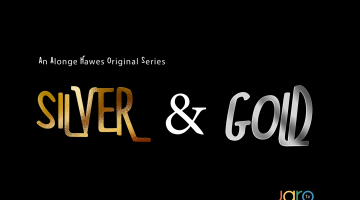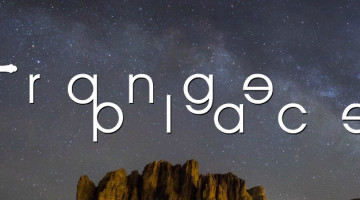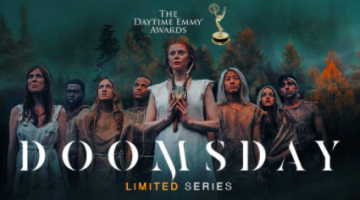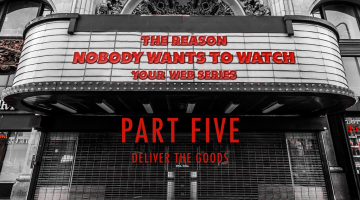This is the second part in a five part series. You can read the previous article exploring the social realities that influence what we watch here.
My dad is what you might call ‘old school.’ This is probably not the biggest surprise, considering that he went to school back in the dark ages. What I mean by old school is that he doesn’t stream. He’s heard of Netflix but he thinks it’s dvds that you watch on the internet. So he’s a big tv guy. He likes the cable tv with the channels and the packages and the sports… oh the sports.
So case in point, the other day he lost his tv remote, which was kind of a big deal because there are no buttons on the cable box he has. Without it he was helpless – forced to watch reruns of The Family Feud when what he really wanted was to watch the baseball game.
Fortunately for him I was able to show him the Fox Sports Go App (I sure as hell wasn’t about to go looking for the remote, which turned out to be in the pocket of the pair of pants he had worn the day before) and he was able to watch the game. After seeing the wonders of the FSG app I showed him the wonders of MLB.tv and the At Bat app. In that moment I felt like I had repaid him for all the things he had introduced me to as a child – except V8 juice, that stuff is still awful.
As content creators one thing we don’t often think about is the difficulty, or inversely the ease of watching our stuff. We might have identified the ideal viewer, that one person we know would love our content but we often forget that viewers are lazy AF.
Think about it – there are people out there who absolutely LOVE Game of Thrones, but they don’t get HBO and they don’t pirate it. They don’t have some moral or ethical issue with piracy, they know exactly where and how they could download it, but they don’t – because they are lazy.
You might not believe me, but this is a perfect description of Hollywood’s anti-piracy policy for the better part of a decade. For years, rather than improving access and availability to digital options they opted instead to make piracy more of a hassle. I’m sure they are responsible for the majority of computer viruses people downloaded from shady portions of the internet during this time period.
I guarantee you that your show has lost viewers due to access and availability issues. Perhaps the biggest of which is, are you where the audience is? Right now there is no better place to be than right in the middle of someone’s Facebook feed. You’d rather put your series on Vimeo, I know, I get it, but your average viewer thinks a Vimeo link is going to give them a computer virus if they click on it. In fact I would wager that simply being in a Facebook users feed is not nearly enough. If you force them to click on a link that takes them to another site, many of them flat out wont do it. Again viewers are lazy AF. All you can hope for, at best, is that you can convince them to click play for just a few seconds, and pray that your first three seconds are so good that they can’t scroll a way.
Now, some of these examples in this article are going to be subtle. Some of these things are going to be out of your control, and some of these things aren’t necessarily a reason why someone didn’t watch your show, but rather why they didn’t watch more of your show.
The Technology That Could’ve Been Used To View Your Content Failed
Yes this one is probably out of your hands, but I wanted to include it anyway because it is the way that technology has changed that has allowed our access to media to grow so significantly in recent years.
My first experience with consuming media had to have come through the medium of television. It was a screen that was just on, a constant stream of video that was pushed into my face. What I experienced through that box was the result of a series of decisions from the network executives who chose what would air and when down to my parents who decided whether to watch or not. There wasn’t much choice for me, and even as I got old enough to control the device myself, it was the broader system of television and cable networks that really controlled my viewing.
The television as a piece of refined technology is fascinating. You press the power button and instantly you are greeted with content from a source you have previously watched. In the old days a turn of the dial left or right would change the inputs and give you your next option. I do not have a single memory of the cable going out as a kid; it was as if access was guaranteed. If you wanted television you could get television instantly.
The simplicity and ease of use was a by-product of its limitations. It was Steve Jobs who was famously adamant that if something took more than 3 user inputs then that process was not user friendly. With the web, smart phones and tablets we are drowning in capability – so much capability that nothing specific is truly simple anymore.
For most of us online content producers our potential audiences are viewing our videos through smart phones and tablets, and these come with a myriad of potential pitfalls that will result in a missed view.
I can’t tell you how many times someone has tweeted me a link to a video and I just couldn’t get enough signal to play it back properly or without buffering. There also was a time not all that long ago where I had to be concerned with data limits, and many people still have plans with data caps or throttling that may imped their ability or desire to click play.
‘Net neutrality’ has also been a big story lately and we can already see potential dangers that have emerged on the mobile side. Companies like T-Mobile will grant customers unlimited access to YouTube content or Netflix videos, while your precious web series on a small indie distributor might count against a data cap, discouraging your viewers.
In addition to issues with flakey service the device itself has limitations. Limited storage space, rapidly discharging batteries, iPhone slow downs and assorted software issues also come into play. For example, I find the YouTube app for iPhone to be one of the least intuitive apps I have ever used. There are many times when I’ve lost track of a video and could never find it again because of the confusing app structure or buggy playback. Part of the problem here is that, in order to get to your channel there is a lot of drill down. First the user has to swipe to the correct screen, select the right app, buffer a list of stuff they aren’t looking for, then access your channel in whichever method they use to find you. The confusing parts of the app, combined with the number of steps can weed out potential viewers.
The Viewing Interface Didn’t Promote Consumption
This is connected with the previous reason. Where the previous reason relates to ways in which hardware fails to allow us to watch, this is all about software that doesn’t promote viewing. Think of it this way… how many times have you watched the next episode of a show on Netflix simply because you couldn’t find the remote, or press the button fast enough to stop the damn thing from starting the next one? When you are on YouTube how many of your views are a result of playlist autoplay, or the next suggested video simply starting?
Old media has a long tradition of using the distribution platform as a means of promoting additional viewing. When your favorite show on ABC ends another show always follows. For years networks have tried to leverage this by creating viewing blocks on new shows on certain days and times of the week. Popular shows are often used as a lead in to newer shows in the hopes that audiences will catch on to a new show and start watching it as rabidly as they did the older show.
In todays digital market we see the same ideas rehashed as MCN’s or large YouTube networks. Growing an audience on YouTube as about more than having one good show, it’s about constant content – it’s about always having another show for the viewer to watch.
As time moves on we are going to see platforms continue to try and leverage our natural viewing instincts by finding new, ever more clever ways to encourage viewers to keep watching. Auto play is just the beginning as future platforms will try all sorts of methods from gamification to premium access to increase viewership.
Again, for most of us this issue is out of our control, but it needs to be part of the discussion when planning our projects and considering their marketing. Some producers have tried to get around the issue of getting lost in a platforms noise by creating their own apps. While this could theoretically provide a better viewing experience potential viewers still have to find your app to download it, and there are many cost related barriers to creating an experience that actually is better.

Old school meets new school
Your Potential Viewer Wasn’t In An Ideal Location To View Your Show
The Home Viewer
So you tweeted out an announcement about the release of your latest episode and I’m busy kicking back in front of the tv in my living room looking for something to watch. Normally one might think this is an ideal time to put on your video but I’m ready to test out the 4k television and that sick surround sound. Can your YouTube embed compete with my BluRay collection?
When we’re at home, parked in front of a television we are looking for the highest quality content. We also are thinking about how easy it is to flip on the tv and watch something on demand. Who wants to watch a video on their phone in that situation?
Now maybe your potential viewer has a smart tv and can load up the YouTube app to play your video. This improves your chances because your viewer can throw up your series on that big screen.
So now you’re thinking, I better make sure my distribution strategy includes placement on a platform with a smart tv app, right? Unfortunately the next issue you face is, does your show match the quality of something else this viewer might be considering on that platform?
I hear this from indie distributors all the time… “We are working on a Roku app!” or maybe “We are available on Samsung Smart tvs!” This is great because it puts your series on the list but there is an inherent flaw in this strategy when it comes to typical web series offerings.
Most of the time when we sit down in front of the tv and open up the Netflix app or check on demand, we are looking through big budget content – block buster movies or big budget original series. This is an area that, even if we can add our series to the list, we will still struggle to compete because it’s hard for tiny indie distributed series to compare to the competition in terms of production value and audience awareness.
The Computer Viewer
So obviously I think home viewing is a virtual lost cause, but that’s not the only place people are willing to watch video. Say you sent out that same tweet and I saw it at work, or while in front of the computer.
This is an ideal scenario for a web series creator because we tend to have reasonably good viewing screens, reliable internet connections and simple, straight forward interfaces for video playback. Computer viewers are also less likely to be overly concerned with top quality video or things like surround sound.
Now you might run into an issue where your viewer is uncomfortable playing back your shows’ audio. When I’m at the computer I am not typically settling in to watch videos, though I’m sure many are, and I might not be willing to play your audio track for all to hear – this is an area where having subtitles can potentially prevent lost views.
Another issue worth considering is that there isn’t much growth in online video viewing on computers. While this distribution medium is well tailored to online video viewing it is not a major growth area and in turn not a major part of the web video boom.
The Mobile Viewer
Of course the big driver of the web video boom is the mobile viewer – someone watching on a smart phone or tablet. It’s important to differentiate between the two because they are very different people in very different circumstances.
First, the tablet viewer is by far the most ideal web series viewer. If you tweet me that link while I’m sitting down on the toilet with the iPad you have an almost guaranteed view. The viewing experience and interface is ideal and the expectation of quality isn’t so great that people are necessarily looking for top shelf production value. If you are targeting tablet viewers then you are doing it right.
Of course the real driver of online video growth are smart phones. If you are tweeting out that link then the odds are huge that your potential viewer is going to see it on a smart phone and if they are to view it they will be viewing it on a smart phone.
This is one of the biggest issues that many in the web series community have consistently ignored. If your series is not optimized for viewing on a smart phone then people on smart phones are generally not going to watch it.
It’s that simple really… People don’t watch a lot of long form content on their phone. They don’t watch all that much narrative content on their phone either. People are on the go, they are on break at work, in between meetings, sitting in waiting rooms, waiting at red lights, texting, distracting themselves from their work, the list goes on.
Smart phone viewers aren’t looking for epic vistas, stunning visuals or amazing sound design because these devices cannot deliver them. The limitations of the device and the nature of how people use it is what allows web video to not only compete with big budget content but to actually thrive.
People also find content completely differently on their phones than they do on a television or tablet. Most of my time on my phone is spent reacting to notifications I have, and once I’ve gone through those I tend to end up going through a feed on one of a few apps I am a fan of, like say Instagram.
With that in mind, your distribution strategy needs to focus on how you can get your content into the feed of your potential viewer – whatever app they might be using. If your show has failed to find an audience then the first culprit is probably your inability to get the show into those feeds.
The bottom line here is that in this new world of digital distribution there are a myriad of viewing situations your potential viewer may find themselves in, and it is up to you to consider them. We can’t design content for theatrical viewing and then expect people to watch on their phones. Content must be designed and marketed with the correct viewing interface in mind.

How many clicks does it take to get to your series from this screen?
Your Show Wasn’t Available Where Your Viewer Was Looking
Similar to the last issue, which focused on the physical location of your potential viewer, this issue focuses on the virtual location of your content. Availability and accessibility are common differentiation strategies in traditional product marketing and in turn they are pretty straight forward when it comes to online video as well.
There are two schools of thought on this one. There are those who say your video content should be available on every possible platform, while others would say that you should focus on doing one platform right and pushing everyone to the same place. There are pros and cons to each one.
The upside of doing one platform is that you can optimize your content and distribution strategy to that one platform and the results of all your efforts will be displayed in one place. If you optimize for YouTube then you give yourself the best chance for succeeding on YouTube. Focusing on one platform also keeps you and your team from spreading themselves too thin at the promotion stage.
The downside of being on just one platform is that your potential viewer might not be looking on that platform. By limiting yourself to just one you are limiting your potential viewing audience. Each distributor can provide a certain amount of network effect, where users of the platform organically come across your content. In order for this to happen though, your show needs to be on the platform first.
The current paid TV landscape has made it so that we need at least four or five paid services in order to have access to the majority of premium content being created today – and those wont include most movies with theatrical releases. While the majority of options we have as web producers aren’t paid it’s important to remember that going this route will eliminate a large chunk of potential viewers. As a producer you then have to weigh your show’s potential reach versus the best, most optimal experience.
Your Show Or Its Distribution Platform Didn’t Get Me Hooked
One of the very first blogs I wrote on Snobby Robot, back in its days on Tumblr, was about a trend being observed in tech where users were quite literally becoming addicted to certain apps. Today, Facebook’s addictive properties are well known, but at the time I pondered how we could or were applying these concepts to our community. If social networks could manipulate us into checking our phones every four minutes then perhaps there is a way to use similar methods to increase viewership and engagement in our shows.
So how does it work? Well, the gist of it is the idea of putting your product out there to be discovered by your target audience at the right time, rewarding them for finding it, and ultimately providing them with the means towards receiving even greater rewards in the future.
The last part is really the key, and also the most difficult. The promise of additional rewards with additional visits is what creates a habit. Once your audience is hooked they will keep returning to your product over and over completely on their own without requiring additional advertising dollars – all while manufacturing good word of mouth.
This is a huge challenge for creators of web series, because a singular web series is not built to be consumed over and over again. While most creators try to generate some continued buzz by scheduling episodically or by uploading tons of special features a singular generic web series is incapable of producing the amount of content needed to even start thinking about becoming habit forming.
In our web video space we see vloggers coming the closest to being able to achieve this. Some common advice you’ll hear given to up and coming YouTubers is to be consistent – to release content on a regular, reliable schedule. Television shows did this for years as well – it’s that consistency that drives home the habit of looking for new content.
The concept of creating habits goes so much deeper than simply operating on a schedule though. Web video hasn’t really taken things to the level Facebook has yet, though we see YouTube trying to incorporate more community features for this purpose specifically. At best your followers will get a notification when your new episode pops, but what about that all important reward?
Facebook is centered around the concept of the ‘like’ – the virtual pat on the back. It’s the company’s way of affirming your contribution to the network and promoting the cycle. Right now we aren’t doing much in the area of rewarding our viewers, or affirming the value of their contributions. When we figure out how, we will stop losing viewers to the week-to-week atrophy and instead find an audience clamoring for their next hit.
As filmmakers first and foremost it is easy to lose track of the more nuanced aspects of the distribution and consumption of new media. Many of us are in this field to show off our abilities as future Hollywood directors, screenwriters or actors – lured in by the openness and unlimited potential of the online world. It can be hard then to consider the very unique aspects of this new form of distribution when your eyes are still on an old one.
While considering how people use the different devices they have along with the strengths, weaknesses and subtleties of them might not be the most interesting part of this series it might be the most important. I say this because it is the technology and how we use it that has created this new medium, and it is our inability to grasp the issues above that prevents us from taking advantage of it. Above all else, it is a lack of refinement in this area that serves as both the creative and business opportunity in front of us.
Continue on to Part 3: The Power of Branding – (9/4/2018)













No Comment